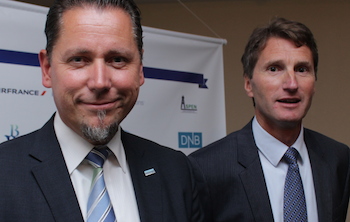Within 30-50 years South America and Asia will be the main shipbuilding hubs in the world, according to DNV GL projections.

“Future of shipping – Sustainable solutions” was the title of a presentation given by Mr. Remi Eriksen, COO and Group Executive Vice President of DNV GL during an NBCC event on August 19, 2014.
The event took place in the Associação Comercial do Rio de Janeiro (ACRJ) in cooperation with Câmara de Comércio e Indústria Brasil-Alemanha (AHK).
In his presentation, Mr. Eriksen outlined the main global trends that DNV GL thinks will have the greatest impact on the future of shipping.
After the merger last year, DNV GL is the world’s largest ship and offshore classification society, a leading technical advisor to the global oil and gas industry, and a leading expert for the energy value chain including renewables and energy efficiency. Mr. Eriksen and the whole board of the company are in Rio de Janeiro to commemorate the 150 years anniversary of DNV, and a dinner for 300 distinguished guests was held at the Copacabana Palace on August 21, 2014.
Game changers
As a result of population growth and economic growth, DNV GL expects to see an increased demand for seaborne transport and trade, changing trade patterns, changes in maritime clusters and a new geography for shipping services.
“We expect an increase in south-to-south trade and inter-Asian trade, and we believe that most shipbuilding will take place in South America and Asia 30-50 years from now”, Mr. Eriksen said.
In addition to population and economic growth, DNV GL has identified three main drivers with a potential to change the future. Information and communication technology, energy and climate change and environment are all areas where Mr. Eriksen highlighted a series of potential game changers.
“The increased capacity of information and communication technology and the increased amount of data will influence how decisions are made and this will be a revolution that will reduce costs of operations and improve safety and efficiency at sea. There will be more automation, maybe unmanned ships, and we will be able to remove sources of human error.”
 Remi Eriksen and Tommy Bjornsen, NBCC board member and former head of DNV Brazil.DNV GL expects the global energy demand to increase, and thinks that gas will become important as fuel for shipping. Fossil fuel will still dominate.
Remi Eriksen and Tommy Bjornsen, NBCC board member and former head of DNV Brazil.DNV GL expects the global energy demand to increase, and thinks that gas will become important as fuel for shipping. Fossil fuel will still dominate.
“Changing the fuel mix will impact what we transport. The use of biofuel will grow and nuclear power is a potential game changer, but public opinion is still an obstacle.”
Public opinion will also be important when talking about climate change, and DNV GL expects the pressure from the population to grow. This is something the industry needs to take seriously and consider constantly.
“Shipping is one of the most sustainable ways of transport, but we still need to reduce the environmental footprint of shipping. A potential game changer could be a future ban on fossil fuel. Unlocking the Arctic could shorten distances and enable the extraction of new resources. New cargo will likely be transported in the future, for instance water.”
Remi Eriksen also presented the study of several pathways towards safer, smarter and greener shipping: DNV GL projects a 60 percent reduction in CO2 emissions, a reduction of 90 percent in fatalities and also expects present freight cost levels to be maintained or even reduced.
“Sustainable shipping is smarter shipping. It also means safer shipping and we believe in a new safety mindset where the ability to monitor preventive and mitigating barriers will increase and give us a more dynamic risk management.”
DNV GL also talks about “the connected ship”, a development that will reduce manning and give smarter maintenance, more automation and more remote operations.
Mr. Eriksen believes that new regulations on sustainability will be a main driver, but also expects new technological solutions to contribute.
“Today we rely on fossil fuels, and this will not continue. It is too expensive and authorities around the world are imposing stricter regulations. So what are the alternatives? Natural gas does not have the footprint we need to keep us within the 2 degree target. DNV GL expects the use of electricity, renewables and biofuel. We will probably also see carbon caption and storage in the future. Currently the cost is too high to make this a viable solution.”
A unique consolidation
After the merger, DNV GL has 16.000 employees around the world. Remi Eriksen was responsible for the merger, and also shared some insights and reflections on this process during the event.
The merger was approved by competition authorities around the world in September 2013.
“This is a unique industry consolidation that also embraces companies like Noble Denton, Kema, Garrad Hassan and Advantica. They are all strong brands with a strong heritage. The integration period started in September 2013. Our priority was to identify key people we wanted to retain early in the merger process. We focused on speed and proven practices to ensure customer satisfaction and chose workable solutions over perfect solutions”, Mr. Eriksen said.
The new shipping part of the company DNV GL has a 24 percent market share, but an impressive 50 percent market share on container ships, meaning that every second ship is classed by either DNV or GL.
By Runa Hestmann, NBCC journalist
(runa.tierno@nbcc.com.br)
:


